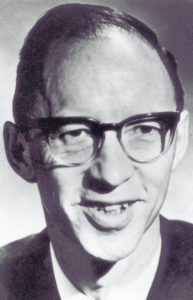Willard W. Blaesser (1956-1957)
Seventeenth President
Willard W. Blaesser was the twelfth man to become president of ACPA. He served his one-year term as president during 1956-57, after he was in office as president-elect for a year. At the time of the election in 1956, he was Dean of Students and Professor of Educational Psychology at the University of Utah. He was 42 years old, married, and the father of three children, two daughters and one son.
was in office as president-elect for a year. At the time of the election in 1956, he was Dean of Students and Professor of Educational Psychology at the University of Utah. He was 42 years old, married, and the father of three children, two daughters and one son.
Blaesser was born in Cedarburg, Wisconsin. He completed the B.S. (1934) and M.A. (1940) degrees at the University of Wisconsin (UW), where he was named Honorary Fellow in 1984. In Wisconsin during 1934-35, he was a Teacher at Milton Union High School. The next year he taught social studies at Sheboygan High School. At UW during 1936-39 he was Assistant Director of Social Education and an Instructor of Education. At UW during 1939-45 he was Assistant Dean of Men and Coordinator of Student Personnel. After one-year assignments at the University of Chicago (1945-46) and University of Montana (1946-47), he accepted an appointment as Dean of Students and Associate Professor of Education at Washington State University (1947-50). On leave during 1949-50, he was named to head the Student Personnel Program, Division of Higher Education, U.S. Office of Education (OE). He left the OE to become Dean of Students and Professor of Educational Psychology for nine years (1953-62) at the University of Utah. He accepted a similar position at the City College of City University of New York during 1962-68. From New York he went to the Southwest and became Professor in the Department of Counselor Education at Arizona State University, where he was selected the College of Education Distinguished Achievement Award recipient in May 1982. He became Professor Emeritus at Arizona State in 1984 and returned to UW.
Blaesser first became a member of ACPA during the 1938-39 membership year. He first appeared on the annual ACPA convention program at St. Louis in 1940, when he was listed as recorder of a discussion group who talked about Coordination of Personnel Work. Blaesser was elected treasurer of ACPA in 1943 for a two-year term, and re-elected to another two-year term in 1945. He was the second man elected to that ACPA office.
At the first post-war convention in 1947 at Columbus, Blaesser presided at the opening general session of ACPA on Saturday morning, March 29, at which time the ACPA president was one of two speakers. Later that morning at the ACPA Business session, Blaesser was announced as the new ACPA vice-president.
During 1947-48 Blaesser served as the ACPA vice president and was a member of the Program Committee. That same year he was president of the Northwest College Personnel Association. At the 1948 annual ACPA convention in Chicago, he served with the ACPA Professional Standards and Training Committee.
At the 1949 convention again held in Chicago, Blaesser presented a paper on “The College Administrator Evaluates Student Personnel Work” at a session labeled Evaluation of Student Personnel Services. He was elected to the ACPA Executive Council for 1949-50. At the 1950 annual convention in Atlantic City on Thursday, March 30, he and another colleague from OE were two of the speakers at a symposium titled “Selection and Training of College Personnel Workers.” Blaesser’s topic was “Major Issues and Trends in the Graduate Training of College Personnel Workers.”
At Chicago during the annual ACPA convention in 1951, Blaesser appeared on the ACPA program opening day as a panel member at a section meeting. The panel discussion focused on the subject of Administrative Problems in Student Personnel Work Arising from Mobilization and the Current Critical World Situation. On the following day, he presented the report of the Council of Guidance and Personnel Associations’ Committee on Manpower Utilization during the morning general session. He chaired that committee.
During 1952-53, Blaesser was a member of the ACPA Nomination Committee, and he was one of 20 ACPA representatives on the APGA Assembly. At the 1953 ACPA convention in Chicago, he presided at an afternoon section meeting and presented a paper on “Student Personnel Approaches to General Education.” Following his presentation, a group of five discussants responded. At the Business session that year, an announcement was made that Blaesser was elected to serve on the ACPA Executive Council as a member-at-large during 1953-54.
Blaesser’s name appeared twice on the 1954 ACPA convention program in Buffalo. After his brief presentation when he presided at a Monday evening, April 12 section meeting titled “Administration of Financial Aids for College Students,” three other participants joined in a discussion of the topic with him. The next afternoon at a section meeting labeled “Civil Liberties on the College Campus,” Blaesser was one of the discussants who read a paper. At the 1955 convention in Chicago, he presided at the Sunday evening, April 3 APGA Activities Committee Business meeting. When he became ACPA president-elect in 1955, he served also as a member of the 1955-56 Program Committee.
The 1956 ACPA convention program included a closing general session called “What Next for ACPA: Policy and Planning.” Blaesser presided at that Thursday morning, March 29 program. Reports of three 1955-56 Committees: Grass Roots Development, Higher Education Relationships, and Policy and Planning, were utilized to consider major issues involved in ACPA’s future. At the ACPA Executive Council meeting that afternoon, when the 1956-57 program was planned. Blaesser requested authorization, with the assistance of the Executive Council, to make a study of ACPA’s immediate and long-range goals.
ACPA members received a lengthy letter dated May 17, 1956 from President Blaesser in which he requested information to help identify ACPA’s role in higher education. Nine committees of ACPA were functioning that year. On Tuesday and Wednesday, October 16-17, 1956 in Detroit, the site of the 1957 convention, Blaesser chaired a workshop group who explored the role and future of ACPA. The “Report of the ACPA Workshop” was published and distributed to the ACPA membership prior to the Detroit meetings. Members were invited to attend the pre-convention workshop arranged for Friday and Saturday, April 12-13. The report of the pre-convention workshop was then considered and acted upon at the two ACPA Business sessions on Monday afternoon, April 15 and Wednesday morning, April 17 at which time President Blaesser presided. He attended the three ACPA Executive Council meetings on Sunday, Wednesday, and Thursday, presiding at the Sunday meeting. At the Executive Council meeting on Wednesday, April 17, chaired by President-elect Kamm, President Blaesser’s motion to authorize the CPA officers to proceed on implementation of the plan to explore functional interrelationships between various groups in college personnel work and then submit recommendations to the ACPA Executive Council for further action was passed unanimously. Agreement during the discussion of the motion was that ACPA would work with the National Association of Women Deans and Counselors (NAWDC, formerly NADW) and NASPA. Other groups were to be invited to attend exploratory meetings. The first session of this Inter-Association Committee, chaired by Blaesser, led to the formation of the Inter-Association Secretariat, later termed the Council of Student j Personnel Associations. At the ACPA Executive Council meeting the next day, Blaesser commented that j ACPA should give more attention to the area of international relations in college personnel work.
Blaesser’s presidential address, “The Forward Look in ACPA,” was presented at the ACPA luncheon and general session at noon on Monday, April 15. He presided at the ACPA special interest session titled A Student Survey of Higher Education on Wednesday morning.
Among the first group of APGA life subscribers in 1957, Blaesser chose ACPA as his primary division. During 1962-63 he was a member of the ACPA Self Study Committee. He served as a member of the Editor Selection Committee during 1963-64. Blaesser served as an ACPA Delegate to the 1968 APGA Senate meeting in Detroit. He served a term on the editorial board of the Journal of College Student Personnel during 1971-74. During 1980-82 he was a member of the Long Range Planning Committee.
At the invitation of President Marvalene Hughes and President-elect Patricia Kearney, he participated in the special leadership conference of the ACPA Executive Council at St. Louis early in November 1987. In “A Time to Speak…” article which was printed in the November 1988 issue of ACPA Developments, Willard Blaesser shared his views about ACPA and the 21st century. An excerpt from that article reads:
…I recommend that ACPA take leadership in the establishment of a Commission on Higher Education that would go far beyond remediation and promoting visibility for student affairs educators. It would be designed to address the goals, issues, and problems of higher education, to identify current and potential contributions of our profession to the developmental needs of students, and the building of educational/developmental communities. The focus would be on moving toward solutions in a collaborative process with teaching faculty, students, and administrators.
In 1991, Blaesser and his wife of 49 years, Helen Ann (Geimer) Blaesser, resided in Madison. Blaesser died on May 4, 1998 in Marlborough, MA. An article in his memory appeared in the February 1999 issue of ACPA Developments.
